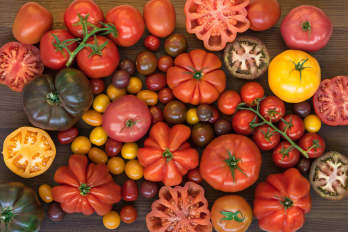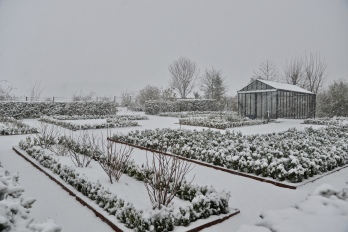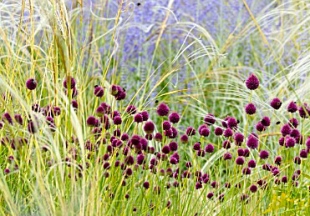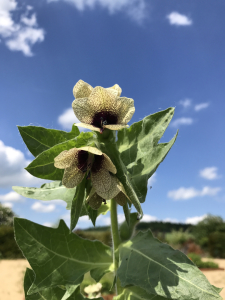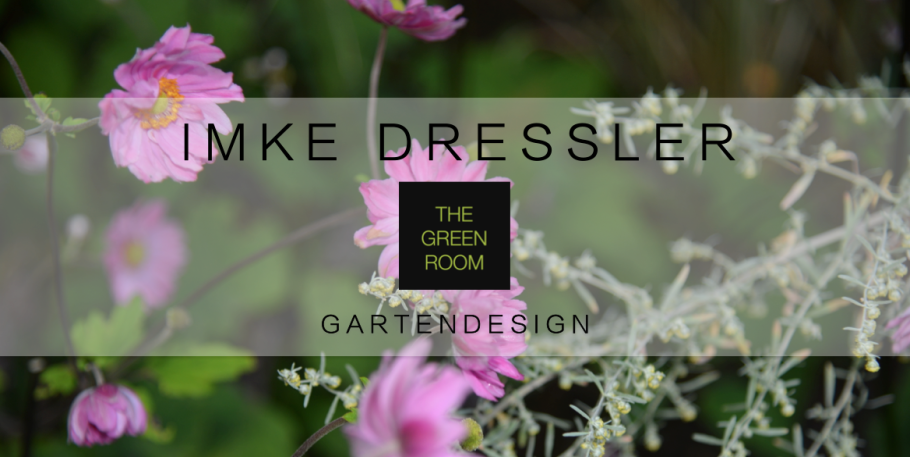
OKTOBER 2023
Garden Safari with the "Big Five
If you've ever traveled to the African continent and had the good fortune to experience the wilderness up close, the term "Big Five" will immediately come to mind. This is how big game hunters
used to refer to elephant, rhinoceros, buffalo, lion and leopard, with the choice not primarily referring to the animals' body size, but mainly to the difficulties and dangers of hunting
them.
To speak of dangers in my garden jungle would be an exaggeration, but difficulties are here and there every day: local weather and changing climate and thus the important choice of appropriate
plants, the time required to manage a large garden and - as in my case - to approach one's horticultural idols.
My "Big Five" are both pioneers of garden design, horticulture, and pioneering the role of women in what was, at least previously, a male-dominated garden landscape. In their respective times, the
Five were influential, original and inspiring, and still are!
I'm talking about William Robinson(1838-1935), the Irish gardener and writer; Gertrude Jekyll (1843-1932), the painter and (garden-) designer; Christopher Lloyd (1921-2006), one of the most
innovative, interesting and masterful gardeners of the 20th century; Beth Chatto (1923-2018), the pioneer of sustainability and garden structure; and Piet Oudolf (b. 1944), the master of imitation
and modern, natural plant design.
All four of the latter probably would not have achieved what they are celebrated for today had it not been for William Robinson's ideas on plant composition in the British landscapes. His sensational
work, "The Wild Garden," literally blew up the usual herbaceous borders to create a new aesthetic: hardy ornamental plants and thus introduce the garden to wild nature to create naturalistic
plantings in meadow, woodland, and on banks.
Getrude Jekyll, a contemporary and close friend of Robinson, was the female part of the great plant designers of the early twentieth century. Her aversion to formal garden structures produced some of
the best examples of the Arts and Craft movement (authentic materials and craft in design). Jekyll's background as a painter greatly influenced her garden design style. She often used subtle
color gradations between warm and cool plant colors to influence the mood of the composition. Without professional training in horticulture, she developed the creation of perennial beds with her fine
sense of color and purposefully developed contrast planting into an artistic discipline.
Why Gertrude Jekyll is still important to me today? Outgrowing her own century through talent, strength and creativity, she was able to leave behind constraints and restrictions of society to create
her own independent career and flourish.
Pushing boundaries, changing the mundane, even revolutionizing it, was also the motto of arguably the most daring horticulturist of our time: Christopher Lloyd. His estate "Great Dixter" was - and
here one finds again surprisingly the red thread of history - prepared by Sir Edwin Lutyens, with whom Gertrude Jekyll had a fruitful garden-architectural collaboration.
Christopher Lloyd's unexpected combinations of native and tropical plants, perennials and annuals, perennials and woody plants made the borders of his large garden a permanent, exuberant garden
party that was and is open to the public at all times.
His work lives on in his many plant cultivars, including one in my garden in the form of a wonderful umbel plant that towers over everything in the border by at least 3 feet. Every year I am happy
that a bit of Great Dixter lives on in my garden.
All great gardeners -like all artists of a time- are linked, and so the path of Christopher Lloyd leads to his pen pal Beth Chatto, the great lady of English garden culture, the heiress of William
Robinson and Gertrude Jekyll. Although naturalistic gardening was already common, Chatto nevertheless pioneered garden structures and brilliant, natural plant combinations that could withstand the
climate at hand. Her most famous and influential garden, the Gravel Garden, started as a horticultural experiment, has never been artificially watered, all plants chosen to survive on their own,
copied from nature! Even more, it deserves great credit for experimentally acquiring the skill of sustainably linking plant combination with form, color and texture. Difficult locations, such as dry
shade or wet zones, did not prevent her to make of them blooming landscapes.
It is precisely this principle of natural adaptation that Piet Oudolf has perfected. Although also an experimental grower, he is equally a pop star, the uber-artist among my idols. He takes the simpler planting structures of Lloyd and Chatto to a level unattainable by most with his complex perennial and grass combinations. Anyone who has visited the New York Highline or the Lurie Garden in Chicago knows what I'm talking about. A seemingly never-ending canvas of color, shape and texture delights more than just the garden enthusiast. Like tightly woven tapestries, the plant community seems to ripple through all seasons. The strongest quality of his plant designs: not an imitation of nature, but an artistic interpretation. Oudolf himself says, "All my work is related to the attempt to recreate the spontaneous feeling of plants in nature."
Who wouldn´t want that? That something goes deeper than what you see. That it reminds us of what lies hidden in nature's genes, the longing for nature, for perfection in the natural.
And so, in my annual battle with my garden ideals, I try to rally the "Big Five" around me and elicit some garden wisdom from them. It's a difficult, sometimes disappointing path, the choices
endless. It's not for nothing that I call them the "Big Five": hunting them down, maybe even capturing them takes patience, passion and knowledge.
But what would life be without challenges?
MARCH 2021
When Emperor Frederick meets the Duke of York...
The bee or insect extinction in general is rightly on everyone's lips, almost daily one reads or hears about this topic. Those who are involved in vegetable growing or organic farming in general,
perhaps even self-sufficient, know of another dying: that of ancient crops. Over thousands of years, people have created their own varieties, adapted to the particular climate. Tens of thousands of
agricultural plants are known, but today only about 150 belong to the select circle that feeds mankind with mass.
Plants that are not efficient enough, that are difficult to keep, or that cannot meet certain standards such as shape, color or weight, fall through the cracks, are sorted out by decree.
With the industrialization of agriculture and the creation of high-performance vegetable varieties that are as uniform as ping-pong balls and that have extremely under-challenged the capabilities
of our taste buds for decades, thousands of old crops have disappeared from our plates. The breeding and sale of commercially available fruit and vegetable varieties are in the hands of a few large
corporations. These ensure that the sale of hybrid varieties (varieties with limited reproductive potential) prevent farmers from producing seed-stable varieties themselves. The result: farmers and
us -the end consumers- in dependence, standardized vegetables and fruits, loss of biodiversity and thus loss of distinctive taste.
Thanks to tireless rescuers like private seed propagator companies, the many passionate hobby gardeners or the Association for the Preservation of Crop Diversity in Germany, historical varieties have
come back from their banishment in recent years. Unfortunately, you don't see these varieties in the supermarket, where strawberries can be found throughout the year, beans are flown in from Kenya
and young potatoes from Cyprus... Everything your heart desires - but does your tongue, too?
Since home-grown tomatoes have been cultivated in our vegetable garden (old cultivars), my tongue doesn't take everything anymore.
Tomato is equal to tomato, always nice and round, smooth and as red as possible? Far from it! From apple-sweet to pineapple-fruity-sour, a bit spicy and almost tingly in the mouth, that's how
varieties such as "Green Zebra", "Orange with Violet Spot", the "Siberian Malachite", "Bern Rose", "Cherokee Purple" or "Pineapple" come along. A colorful tomato salad can not be more international
and is a real eye and taste bud opener.
The list of almost lost vegetables can be continued arbitrarily and long. Potatoes in blue, red and purple are not newfangled breeds, but were probably commonplace a hundred years ago in Scotland,
Scandinavia or France, delicate pole and bush beans often from the American continent, were taken from their homeland by German emigrants at the beginning of the 20th century.
Some hardy fruit varieties find their way back to us from the far reaches of Eastern Europe. The frost-tolerant, strongly aromatic peach "Miracle of Perm", to name just one example, was once
brought to Germany from the Urals 200 years ago. Unfortunately, you can't buy it as a fruit in the store, but some German nurseries offers it, along with many heritage lover's varieties, as small
trees.
Besides my favorite plums and mirabelles from grandma's times, purple and yellow bush beans, old Native American corn and some historic potato and cabbage varieties grow on the neighboring bed.
That's where the "Duke of York" beams at me when I carefully dig up the soil in early summer: it's namely a particularly delicious pink potato that stands harmoniously in mixed culture with "Kaiser
Friedrich", the butter bean. Historically, the meeting of these two gentlemen would have been absolutely impossible, and so they meet on my plate over 120 years later, a truly historic event and
guaranteed one for my taste buds.
DECEMBER 2020
Are you planting already or are you still searching?
My inner bastard lives in my garden. He always has. He squats there waiting for spring to arrive, for the garden centers to open, or for my favorite perennial nursery to announce that gardening
season is upon us! Then, he thinks, his time has come to cause as much trouble as possible.
You know that feeling you get when you flip through a gardening magazine or walk through a nursery?
The avid garden lover knows that he MUST turn his entire garden upside down, scrap old plans, try new planting combinations, and make the seed manufacturers of this world a little richer! Well,
actually...choosing plants in a frenzy of the senses is like shopping at the supermarket when you're hungry: not a good idea! The old rotter rages - of course, he is only to be met if you follow a
very strict plan.
To escape the plant addiction, ask yourself these simple questions: What are the climatic conditions of my garden, how is the soil structured, where are sunny and shady areas, are there dry or wet
zones? With these markers, the selection of potential plant candidates is already reduced considerably. A marsh marigold, as the name suggests, does not like to grow in a rock garden, and a lush
rhododendron is the rare exception to a limestone area.
Those interested in more long-lived structures, plant environmentally-typical. Certainly, most of today's perennials are not native, but have been established for many decades, if not centuries,
and are now well adapted to our climate.
The counter-argument that gardens are, after all, artificial sites anyway, in which (garden) art can be driven up the wall, so to speak, does not go unheard. Yes, with a lot of time, soil
replacement, fertilizer and winter protection, one or the other species of exotics will survive even in our latitudes. But most garden owners, and I count myself among them, naturally want to garden
successfully. The mishaps and setbacks come all by themselves with simpler tasks than that of overwintering oleander and co.
My credo: layer planting with climate-favorable varieties! It is the simple but effective formula for planting designs when it comes to spaces.
My concern is not to copy nature completely, but to implement my own interpretations and variations with nature-like planting. Prairie grasses or tall ornamental mints from North America can swing together and ground covers from Asia can conquer a shade bed with the native foxglove. They are all climatically adapted and tested for our latitudes. In the selection of shrubs and trees I limit myself more. Tulip trees, for example, look fantastic in parks or large, public spaces, but would simply overwhelm everything else in most of our gardens because of their size. Why not try the native serviceberry (Amelanchier, up to about 7m), a hawthorn (Crataegus crus-galli) or a smaller maple? All three offer enchanting spring blossoms, a pleasing growth habit and, for the most part, a breathtaking display of color in the leaves and fruit in the fall. Woody plants such as the buckthorn (Rhamnus) have unfortunately been completely forgotten, but it is the food source for brimstone butterflies and an important landing site for bees and other insects. The evergreen barberry (Berberis julianae) or the semi-evergreen firethorn (Pyracantha) can replace the large-leaved cherry laurel shrubs that I dread. One will be amazed to find that there is an incredibly wide range of native woody plants that, cleverly planned, can be combined to create a bird and insect sanctuary without making it look like an untamed hedge.
Many regional nurseries are helpful for the selection and procurement of woody plants and those who have more specific wishes can also find high-quality nurseries via the Internet.
And what does the inner bastard say? He rubs his hands, knowing full well: even of the native species there are so many beautiful varieties that you will again be spoiled for choice and probably buy
completely different than the so carefully made plan prescribes. Stay strong!!
JUNI 2020
"Do you know what summer smells like ? "...
"...of pears and of carnations, of apples and forget-me-nots wilting in the sun, of hot sand and cool lakes and wet swimming trunks, of beach ball and sunscreen, of road dust and roses..."
This is a song that, thanks to a kids TV show, we have sung together with our children for quite a few summers! Not only does it have content-heavy lyrics- it is, for me at least, extremely true.
When I think back to my childhood - and I often do since we are the parent generation ourselves - I see few everyday images, but mainly feel those scenes of freedom as sung about above: Long days of
roaming through fields, forests and meadows. The rare sight of our parents on weekends because of extended field trips with friends; disheveled, dirty children returning home in the evening with
correspondingly hungry stomachs. I smell the salt marshes by the sea, hear the crash of waves during long summer vacations, and yes, see the perpetual flutter of insects over the hot trails and along
the cool streams next to our camps. This may sound cheesy, but it has actually been that way.
What have we roamers not seen, heard, tasted and smelled! The nose is a great invention of nature! In my case, memories are less detailed images than smells. My childhood, at least that's how it
feels today, was a cocktail of scents from salt marsh, red poppies and sweet mock-orange, which exuded its perfume from predominant bushes right outside my bedroom window in July. Looking back, my
grandparents' garden smells to me primarily of white daffodils, peonies, and deliciously crisp clear summer apples that my grandpa used to fetch for me from the very top of the tree with his long
apple picker. Autumn followed with the nutty aroma of acorns and chestnuts, terribly sour, still unripe sloe berries, potato fires, earthy smelling piles of leaves and asters, with the typical spicy,
pungent scent of chrysanthemums.
It's no wonder, then, that I've made it one of my top personal missions to bring these aromas back to my own garden, as the preserved childhood, so to speak.
Early to late summer offers a potpourri of diverse scents that just have to make you happy, while fall can seduce melancholy, gentle noses.
Who, as a gardener, doesn't dream of spending a warm spring evening under a beguiling smelling lilac or viburnum, letting one's hands roam over softly swaying grasses along the path and sinking
deep into the scent of wild herbs? The sweet, fruity and heavy notes are certainly at the top of the top 10 scent list for most, lily of the valley, for example, should not actually be missing in any
fragrance garden. Neither should the sweet mock-orange (Philadelphus), wild roses, lavender, annual sweet peas, bearded carnations and buddleja. The latter is not only a feast for the eyes but also
an attraction for insects. The honey-scented flowers of the buddleja provide a resting and feeding place for butterflies and bees alike.
But the most beautiful thing for me is the smell of a summer meadow, which spreads countless scents with the rising warmth. Sage, margarites, grasses, bedstraw, scabiosa, clover, wild mallow....
Since I planted our own wild meadow, I walk around it almost once a day in the summer, marvel at the new plants, rejoice at every insect that lands on a flower, see butterflies, bumblebees and wild
bees that have become rare. I imagine that this piece of meadow has created a little sanctuary, not only for me! And when the weather and time permit, I just sit down in the grass and let the meadow
sway around me and the insects flutter - just like in the old days.
MÄRZ 2020
All theory (and practice ) is not gray !
In my 30+ years of lived gardening practice, I've come across a few, if not hundreds, of articles on garden re-design. I must confess, they have rarely been helpful to me. It is, of course,
extremely fruitess to write in general terms about garden design when every patch of green constitutes a different biotope. You will feel the same with this article. But well-intentioned tips from
renowned magazines such as: "Consider abandoning the lawn in favor of a decorative area of gravel and chippings", "Have you thought about a privacy hedge of cherry laurel to the neighbor?" or "So
simply you plan your low-maintenance garden!" sometimes explain, however, why it looks the way it does in many gardens: uniform and boring, sterile. Reports about the creation of a low-maintenance
garden belong to the fakenews, by the way.
Or let's put it this way: what is commonly understood as "low-maintenance layouts" are not gardens, at least not for me! Not even the front garden consisting of gray split gravel, framed by equally
dark gray fences, which currently seem to sprout like mushrooms from the ground, is easy to handle. Sure, you don't have to do perennial care, but weeds are smart, nature will find its
way.
What newcomers to gardening need are tangible examples of the optimal sustainable green design, regardless of the size of the plot.
The smallest garden I ever planned, a backyard in Oxford, England, measured 8x5 m and was to include trees, paths, a seating area by a water feature, and seasonally attractive perennial plantings.
Who would have thought - it turned out to be a little green oasis! It's simply always a question of size and form, because dwarf plant forms exist for (almost) all varieties; ground covers are
essential and long-lasting beds need stable planting structures! But how do you get started?
If you were born without a green thumb, don't despair! Attractive gardens can also shine with native woody plants, frugal perennials, bulb flowers, and natural materials for paths and seating areas.
More advanced and ambitious garden owners play with ornamental grasses, group plantings of perennials, and more challenging shrubs and small trees.
1) In any case, the climatic situation is the starting point for planning: in our latitudes, Mediterranean shrubs tend to thrive less, whereas native plants with a similar look can be quite
close to the original and can withstand increasingly hot and dry summers without any problems. Example: instead of an olive tree, the silvery-leaved ornamental pear Pyrus salicifolia can be used,
complemented by groups of lavender, saint's weed, spurge and softly swaying grasses.
2) Create spaces and visual axes. Even a small garden needs a consistent division. Use the favorite spot in the house to look out onto a central point in the garden. A path can wind behind a hedge where your new seating area is next to a fragrant mock orange (Philadelphus) or lilac, tall grasses surround the area and remain attractive into winter.
3) SHOP LOCAL!!! Regional nurseries offer a wide selection of beautiful woody plants. Get high-quality plants. You'll find them, along with expert advice, at your local garden centers.
4) ... and PLANT LOCALl! Keep an eye on the climate and soil conditions! The more natural, that is, adapted to the environment you plant, the longer lasting the beds will be. It is better to plant
fewer varieties, but in groups. This increases the stability and the color effect.
5) Think of the bird and insect world. Seed stands in the bed not only create a beautiful silhouette in winter, but serve as a food source for birds.
6) Above all: don't carry the garden as a burden, but design it as your green living room, a quiet zone, a cottage garden, a self-sufficiency area, a small park, and always as a biodiverse place that lets you become part of nature again.
NOVEMBER 2019
"What is there that is not poison?"
...All things are poison and nothing is without poison.
Only the dosage makes a thing not a poison."
This is how the Swiss physician Paracelsus, who was fond of experimenting, wrote it at the beginning of the 16th century, and with statements like this he made himself considerably unpopular in his
time, not only in medical circles.
On the whole, one certainly agrees with his statement, but there are toxins that would have to be administered in such minimal doses that it would not be advisable to use them as remedies for home
use. The prerequisite for the conscious use of plants as natural remedies is in any case the knowledge of the healing plants of nature. And therein lies the crux: hardly anyone still knows what grows
in the meadow, in the forest, in the garden or even in the flower pot at home.
Since Paracelsus' times, we have distanced ourselves more and more from nature, we live decoupled from our environment and see greenery as something that is "out there", without realizing that we are
still a part of it. At the same time, knowledge about the active ingredients of plants belongs to the primordial knowledge of mankind. With today's ignorance comes prejudice and bad decisions; we
banish some poisonous plants from our gardens to replace them, ignorantly, with others. How often do we hear that foxglove is not tolerated in the garden; the laburnum, autumn crocus, honeysuckle,
laurel cherry and even boxwood, on the other hand, are gladly used in plantings, but these are just as poisonous, some even many times more poisonous or at least have toxic components.
The beautiful monkshood (Aconitum napellus), often planted in shady areas, is one of the most poisonous plants in Europe. If it is only used as a medicine in very small doses, it relieves nausea,
vomiting and diarrhea, but just touching it can be enough to cause a skin rash due to the poison aconitine, 2-5 leaflets of the plant can be fatal.
Only the knowledge about the active substances of the plants allows us to integrate them consciously into our environment and to enjoy them despite the danger.
Poisons have been used intensively by indigenous people for thousands of years and are still used today. Phytotoxins used by South American tribes for hunting, such as curare, although synthetically
improved today, are an important part of our modern medicine. Just like the atropine of belladonna, the opium of poppy, the strychnine of nux vomica in homeopathy or the glycosides of foxglove, lily
of the valley or oleander. Mandrake (Mandragora officinarum), a nightshade plant often used in the Middle Ages as a "woman's herb" - like the tomato and potato, by the way! - acts as an extremely
powerful hallucinogen, as it contains a whole cocktail of toxins, including alkaloids. Well knowing not to brew tea from it, it grows in my garden, a musthave for herb witches, botanists and Harry
Potter fans! With previous enlightenment of the family members, of course.
Let's not give up the delphinium, elderberry, spurge, ferns, poppy and the weeping heart (poisonous plant of the year 2017), angel's trumpet, which winds its way up many terrace walls or pergolas,
black locust, Christmas rose and hydrangea, which, by the way, contain prussic acid compounds, as well as the bush bean in the vegetable garden!
But enough of the poisonous representatives of the garden. Equally pleasing and even more helpful for home use are the medicinal herbs, which can be put in tea or bath water without hesitation.
Thyme, mint, sage and Co. are the gladly welcomed representatives of the herb border, while e.g. camomile, ribwort plantain or coltsfoot, as "weeds" hacked away, help by their active substance
complexes however most effectively with respiratory diseases. A whole armada of natural helpers would be available to us if we would only pay more attention to them.
Knowledge and sharing of knowledge is the essence of navigating the herbal universe.
However, I too was completely ignorant recently when a friend offered me her paracress as a most interesting medicinal plant to chew on! Biting into a paracress flower is an experience you will never
forget for the rest of your life! An initial sharp taste was followed by a bitter-burning tingling sensation, followed by a long-lasting numbness in the mouth, which, in my case, was accompanied by
considerable salivation. If I had been told what it is about the effect of this plant, I would have made myself a cream from it, because who did not know it - like me - yet: Paracress is the new
Botox!
